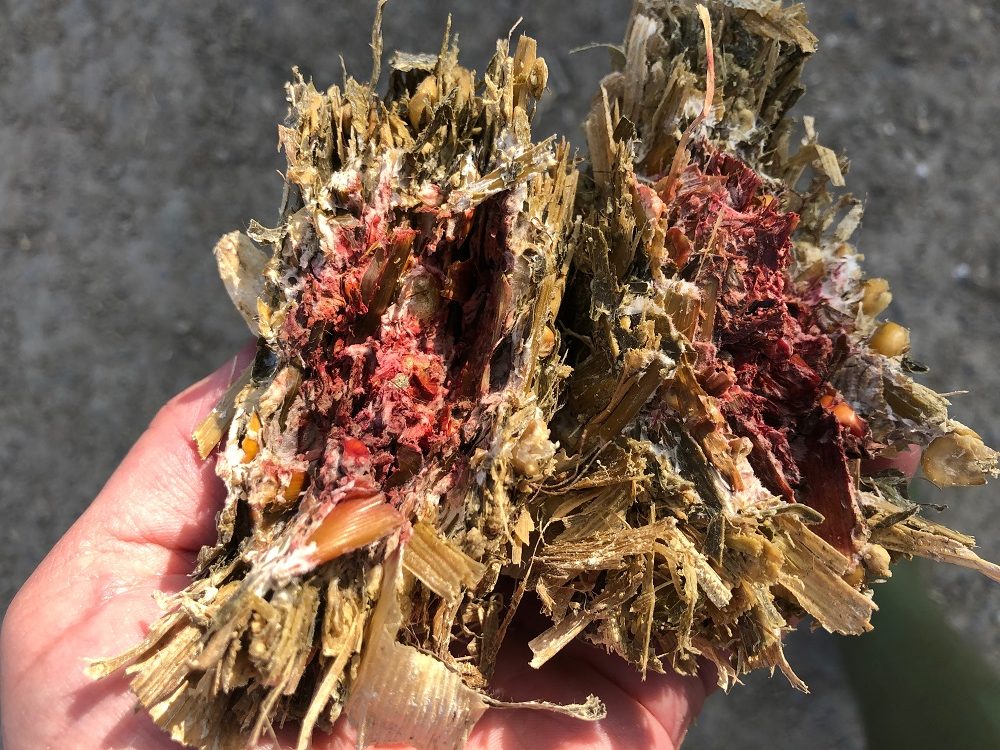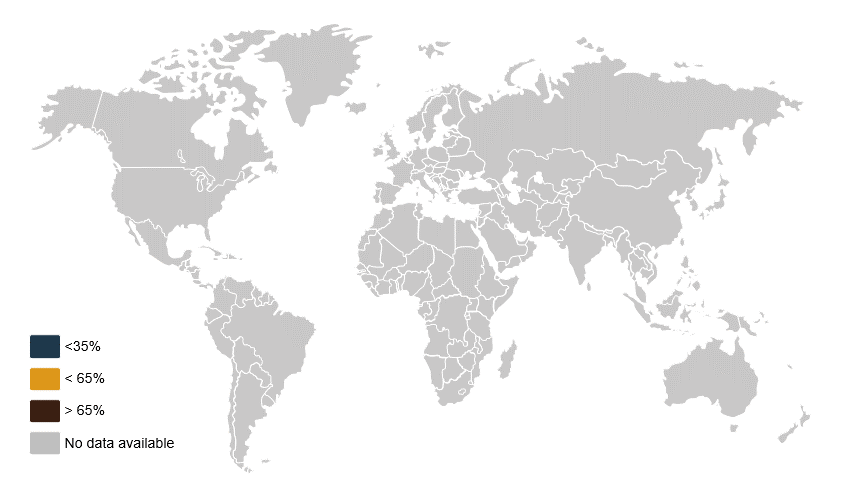Prevalent across most of the globe, members of the Fusarium genus produce many important mycotoxins: zearalenone, fumonisin, and trichothecenes (like DON or T-2). Often referred to as a field toxin, this mold predominantly infects corn but is also found in forage grasses and cereal grains like wheat, barley, rye, and oats.
Since Fusarium is a ‘field mold’, fusarium contamination is assumed to be consistent from field to feed. Once it infects a lot, the mold is present throughout the rest of the chain. Species of this genus can secrete toxic secondary metabolites in the plant during the growing period. The most frequently mentioned Fusarium mycotoxins are:
There is no evidence for carry-over of Fusarium mycotoxins or altered metabolites from the feed through animals to humans. Human exposure is mainly through cereals and foods produced from cereals.


Highly bioavailable, zearalenone (ZEA) is mainly produced by the molds Fusarium graminearum and Fusarium culmorum and found in corn, corn by-products, barley, wheat, oatmeal, sorghum, sesame seed, hay, and silages. This secondary metabolite has a unique mode of action, one of deceit. It resembles oestradiol, the principal hormone produced by the ovary. Once metabolized, ZEA binds and blocks estrogenic receptors in the uterus and mammary glands, preventing natural processes required for reproductive health, especially in cattle and swine.

Zearaleonone is further metabolized in the liver into either the less dangerous compound beta-zearalenone or alpha-zearalenone. Alpha-zearalenone is estimated to have a toxicity of up to 92x higher than the non-metabolized form of ZEA. Pigs typically metabolize ZEA into α-ZEA while poultry and cattle metabolize ZEA into β-ZEA.
The signs and symptoms of ZEA predominantly originate from the reproductive organs:
| Commodity | Advisory limit |
|---|---|
| Cereal and cereal products (except maize by-products) | 2 ppm |
| Maize by-products | 3 ppm |
| Complementary and complete feeding stuffs for piglets and gilts (young sows)
Complementary and complete feeding stuffs for sows and fattening pigs |
0.1 ppm
0.25ppm |
| Complementary and complete feeding stuffs for calves, dairy cattle, sheep (including lamb), and goats (including kids) | 0.5 ppm |
Most common of the Fusarium toxins, fumonisin B1 is typically produced by Fusarium proliferatum, Fusarium moniloforme, and Fusarium verticillioides. Though believed to have low bioavailability, this toxin is very prevalent, heat-stable, and occurs worldwide; especially in corn. Once absorbed, fumonisin B1 targets the liver, brain, and kidneys to reduce lipid metabolism, diminish epithelial cell renewal, and trigger immune cell apoptosis.

The toxin disrupts the plasma membrane in both plant and animal species and is through to cause an accumulation of toxin shingolipid intermediates. Signs and symptoms include:
| Commodity | Advisory limit |
|---|---|
| Maize and maize by-products | 60 ppm |
| Complementary and complete feeding stuffs pigs, horses, rabbits, and pet animals | 5 ppm |
| Complementary and complete feeding stuffs for fish | 10 ppm |
| Complementary and complete feeding stuffs for poultry, calves (<4 months), lambs, and kids | 20 ppm |
| Complementary and complete feeding stuffs for adult ruminants (>4 months) and mink | 50 ppm |
| Commodity | Advisory limit |
|---|---|
| Corn and corn by-products intended for equids and rabbits | 5 ppm (Feeding rate not to exceed 20% of the diet) |
| Corn and corn by-products intended for swine and catfish | 20 ppm (Feeding rate not to exceed 50% of the diet) |
| Corn and corn by-products intended for breeding ruminants (incl. lacating dairy cows), breeding poultry (incl. laying hens), and breeding mink. | 30 ppm (Feeding rate not to exceed 50% of the diet) |
| Ruminants> 3 months old being raised for slaughter and mink being raised for pelt production | 60 ppm (Feeding rate not the exceed 50% of the diet) |
| Poultry being raised for slaughter | 100 ppm (Feeding rate not to exceed 50% of the diet) |
| All other species or classes of livestock and pet animals | 10 ppm (Feeding rate not to exceed 50% of the diet) |
Produced by various Fusarium species—Fusarium graminearum, Fusarium sporotrichioides, Fusarium poae, Fusarium colmonum, and Fusarium equiseti—trichothecenes are a group of over 150 chemically related mycotoxins. They primarily act by inhibiting protein synthesis on a ribosome level at all three stages of protein synthesis: initiation, elongation, and termination.
When trichothecenes inhibit protein synthesis in the mitochondria, it causes reactive oxygen species (ROS) to build up in the cell, inevitably leading to oxidative stress and induction of the programmed cell death pathway, apoptosis. These inhibitory effects are seen most dramatically in actively proliferating cells such as the gastrointestinal tract or bone marrow.
Trichothecenes are heat stable and classified as gastrointestinal toxins, dermatotoxins, immunotoxins, hematotoxins, and gene toxins. Symptoms and signs include:
The T-2 toxin can be partially metabolized (deacetylated) into HT-2; both forms are the most toxic mycotoxins among the trichothecene group. Common in temperate regions and cereals, Fusarium sporotrichioides is a well-known producer of T-2 toxins. Even though T-2 is rarely detected, monitoring for this toxin is advised due to its potent production of harmful mycotoxins.
 Gruber-Dorninger et al., Global Mycotoxin Occurrence in Feed: A Ten-Year Survey (2019).
Gruber-Dorninger et al., Global Mycotoxin Occurrence in Feed: A Ten-Year Survey (2019).
T-2 is highly toxic when inhaled. Acute toxic symptoms include:
| Commodity | Advisory limit |
|---|---|
| Cereal products for feed and compound feed (*) | |
| Oat milling products (husks) | 2,000 ppb |
| Other cereal products | 500 ppb |
| Compound feed, with the exception of feed for cats | 250 |
Typically produced by F. graminearum and F. culmorum, deoxynivalenol (DON/vomitoxin) is less toxic than T-2 but is still significant to animal agriculture because it is commonly found in feed at high levels. Part of the reason DON is so prevalent is the mold’s reaction to low pH environments, like silage, and the stress triggers mycotoxin production.

Due to its mode of action, binding to the ribosome, DON exposure can result in cytokine production to cause inflammation-based symptoms like:
| Commodity | Advisory limit |
|---|---|
| Grains and grain by-products for ruminating beef and feedlot cattle over 4 months and chickens | 10 ppm (Feeding rate not to exceed 50% of the diet) |
| Grain and grain by-products for swine | 5 ppm (Feeding rate not to exceed 20% of the diet) |
| Grain and grain by-products for swine | 5 ppm (Feeding rate not to exceed 40% of the diet) |
Would you like to be kept informed of our latest developments? Register here and stay up to date.
"*" indicates required fields
| Cookie | Duration | Description |
|---|---|---|
| cookielawinfo-checkbox-analytics | 11 months | This cookie is set by GDPR Cookie Consent plugin. The cookie is used to store the user consent for the cookies in the category "Analytics". |
| cookielawinfo-checkbox-functional | 11 months | The cookie is set by GDPR cookie consent to record the user consent for the cookies in the category "Functional". |
| cookielawinfo-checkbox-necessary | 11 months | This cookie is set by GDPR Cookie Consent plugin. The cookies is used to store the user consent for the cookies in the category "Necessary". |
| cookielawinfo-checkbox-others | 11 months | This cookie is set by GDPR Cookie Consent plugin. The cookie is used to store the user consent for the cookies in the category "Other. |
| cookielawinfo-checkbox-performance | 11 months | This cookie is set by GDPR Cookie Consent plugin. The cookie is used to store the user consent for the cookies in the category "Performance". |
| viewed_cookie_policy | 11 months | The cookie is set by the GDPR Cookie Consent plugin and is used to store whether or not user has consented to the use of cookies. It does not store any personal data. |
